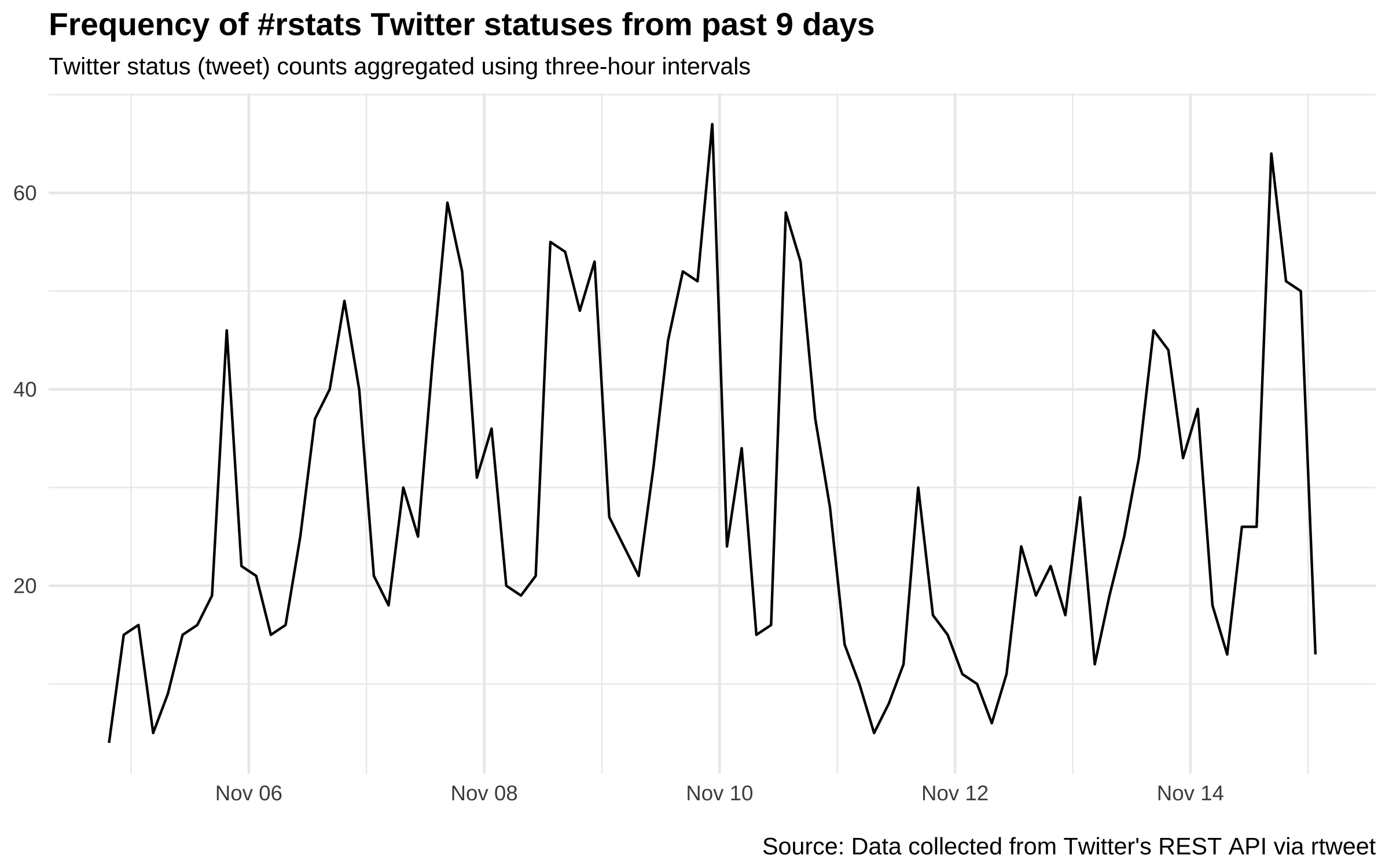R client for accessing Twitter’s REST and stream APIs. Check out the rtweet package documentation website.
To get the current released version from CRAN:
## install rtweet from CRAN
install.packages("rtweet")
## load rtweet package
library(rtweet)To get the current development version from Github:
## install devtools package if it's not already
if (!requireNamespace("devtools", quietly = TRUE)) {
install.packages("devtools")
}
## install dev version of rtweet from github
devtools::install_github("mkearney/rtweet")
## load rtweet package
library(rtweet)All you need is a Twitter account and you can be up in running in
minutes! + See the auth vignette for instructions on obtaining access
to Twitter’s APIs: http://rtweet.info/articles/auth.html.
- To access Twitter’s APIs, go to
apps.twitter.com and create a new app
by completing the form fields (note: users must enter the value
for
Callback URLexactly as it appears below):Name: Name of Twitter app e.g.,mwk_twitter_research_appDescription: Describe use case e.g.,for researching trends and behaviors on twitterWebsite: Valid website e.g.,https://twitter.com/kearneymw***Callback URL***:http://127.0.0.1:1410
- Check yes if you agree and then click “Create your Twitter application”
- Click on tab labeled
Keys and Access Tokens- Copy consumer (api) and secret keys and paste (along with app name) into R script
- Use
create_token()to save token as an environment variable (so you don’t have to worry about doing this process again in future R sessions).
## create token and save it as an environment variable
create_token(
app = "rtweet_token",
consumer_key = "XYznzPFOFZR2a39FwWKN1Jp41",
consumer_secret = "CtkGEWmSevZqJuKl6HHrBxbCybxI1xGLqrD5ynPd9jG0SoHZbD")And that’s it! You’re ready to start collecting and analyzing Twitter data!
Search for up to 18,000 (non-retweeted) tweets containing the rstats hashtag.
## search for 18000 tweets using the rstats hashtag
rt <- search_tweets(
"#rstats", n = 18000, include_rts = FALSE
)Quickly visualize frequency of tweets over time using ts_plot().
## plot time series of tweets
ts_plot(rt, "3 hours") +
ggplot2::theme_minimal() +
ggplot2::theme(plot.title = ggplot2::element_text(face = "bold")) +
ggplot2::labs(
x = NULL, y = NULL,
title = "Frequency of #rstats Twitter statuses from past 9 days",
subtitle = "Twitter status (tweet) counts aggregated using three-hour intervals",
caption = "\nSource: Data collected from Twitter's REST API via rtweet"
)Twitter rate limits cap the number of search results returned to 18,000
every 15 minutes. To request more than that, simply set
retryonratelimit = TRUE and rtweet will wait for rate limit resets for
you.
## search for 250,000 tweets containing the word data
rt <- search_tweets(
"data", n = 250000, retryonratelimit = TRUE
)Search by geo-location—for example, find 10,000 tweets in the English language sent from the United States.
## search for 10,000 tweets sent from the US
rt <- search_tweets(
"lang:en", geocode = lookup_coords("usa"), n = 10000
)
## create lat/lng variables using all available tweet and profile geo-location data
rt <- lat_lng(rt)
## plot state boundaries
par(mar = c(0, 0, 0, 0))
maps::map("state", lwd = .25)
## plot lat and lng points onto state map
with(rt, points(lng, lat, pch = 20, cex = .75, col = rgb(0, .3, .7, .75)))Randomly sample (approximately 1%) from the live stream of all tweets.
## random sample for 30 seconds (default)
rt <- stream_tweets("")Stream all geo enabled tweets from London for 60 seconds.
## stream tweets from london for 60 seconds
rt <- stream_tweets(lookup_coords("london, uk"), timeout = 60)Stream all tweets mentioning realDonaldTrump or Trump for a week.
## stream london tweets for a week (60 secs x 60 mins * 24 hours * 7 days)
stream_tweets(
"realdonaldtrump,trump",
timeout = 60 * 60 * 24 * 7,
file_name = "tweetsabouttrump.json",
parse = FALSE
)
## read in the data as a tidy tbl data frame
djt <- parse_stream("tweetsabouttrump.json")Retrieve a list of all the accounts a user follows.
## get user IDs of accounts followed by CNN
cnn_fds <- get_friends("cnn")
## lookup data on those accounts
cnn_fds_data <- lookup_users(cnn_fds$user_id)Retrieve a list of the accounts following a user.
## get user IDs of accounts following CNN
cnn_flw <- get_followers("cnn", n = 75000)
## lookup data on those accounts
cnn_flw_data <- lookup_users(cnn_flw$user_id)Or if you really want ALL of their followers:
## how many total follows does cnn have?
cnn <- lookup_users("cnn")
## get them all (this would take a little over 5 days)
cnn_flw <- get_followers(
"cnn", n = cnn$followers_count, retryonratelimit = TRUE
)Get the most recent 3,200 tweets from cnn, BBCWorld, and foxnews.
## get user IDs of accounts followed by CNN
tmls <- get_timelines(c("cnn", "BBCWorld", "foxnews"), n = 3200)
## plot the frequency of tweets for each user over time
tmls %>%
dplyr::filter(created_at > "2017-10-29") %>%
dplyr::group_by(screen_name) %>%
ts_plot("days", trim = 1L) +
ggplot2::geom_point() +
ggplot2::theme_minimal() +
ggplot2::theme(
legend.title = ggplot2::element_blank(),
legend.position = "bottom",
plot.title = ggplot2::element_text(face = "bold")) +
ggplot2::labs(
x = NULL, y = NULL,
title = "Frequency of Twitter statuses posted by news organization",
subtitle = "Twitter status (tweet) counts aggregated by day from October/November 2017",
caption = "\nSource: Data collected from Twitter's REST API via rtweet"
)Get the 3,000 most recently favorited statuses by JK Rowling.
jkr <- get_favorites("jk_rowling", n = 3000)Search for 1,000 users with the rstats hashtag in their profile bios.
## search for users with #rstats in their profiles
usrs <- search_users("#rstats", n = 1000)Discover what’s currently trending in San Francisco.
sf <- get_trends("san francisco")- Posting (tweeting from R console) or reading direct messages require additional permissions
- If you’d like to post Twitter statuses, follow or unfollow accounts, and/or read your direct messages, you’ll need to create your own Twitter app.
- To create your own Twitter app, follow the instructions in the authorization vignette on obtaining and using access tokens.
Quick overview of rtweet package
## quick overview of rtweet functions
vignette("intro", package = "rtweet")## working with the stream
vignette("stream", package = "rtweet")Communicating with Twitter’s APIs relies on an internet connection, which can sometimes be inconsistent. With that said, if you encounter an obvious bug for which there is not already an active issue, please create a new issue with all code used (preferably a reproducible example) on Github.




